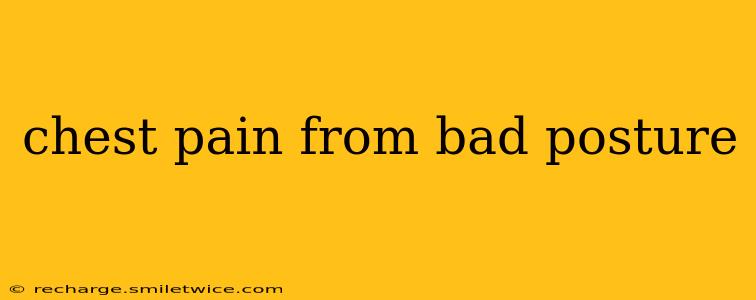Poor posture is a surprisingly common culprit behind chest pain. While serious heart conditions are always a possibility, many experience chest discomfort stemming from musculoskeletal issues directly related to how they hold themselves. This article explores the link between bad posture and chest pain, examining the underlying causes and offering practical solutions for relief and prevention.
How Does Bad Posture Cause Chest Pain?
Bad posture, particularly slouching or hunching, can lead to chest pain in several ways:
-
Muscle Strain and Tension: Constantly slouching puts undue stress on the muscles in your chest, back, neck, and shoulders. This leads to muscle strain, tightness, and spasms, which can manifest as chest pain, often described as aching, tightness, or pressure. The pectoralis muscles (chest muscles) can become shortened and tight, while the muscles in the upper back (like the rhomboids and trapezius) can become weak and overstretched, creating an imbalance that contributes to discomfort.
-
Restricted Breathing: Poor posture can restrict your breathing capacity. Hunching forward compresses your rib cage, limiting the expansion of your lungs and making it harder to take deep breaths. This can lead to shortness of breath and chest tightness, mimicking symptoms often associated with heart problems.
-
Nerve Compression: The nerves running through your neck and upper back can be compressed by poor posture. This compression can lead to referred pain, where the pain is felt in a different location than the source. Compressed nerves can radiate pain to the chest, causing discomfort and potentially numbness or tingling in the arms.
-
Increased Spinal Curvature: Prolonged poor posture can exacerbate existing spinal curvatures like kyphosis (hunchback) or scoliosis. These curvatures can put pressure on the rib cage, causing chest pain and discomfort.
What are the Symptoms of Chest Pain from Bad Posture?
The symptoms of chest pain related to posture typically differ from those of a heart attack. While a heart attack can present with sudden, severe, crushing chest pain, posture-related pain tends to be:
- Gradual onset: The pain usually develops gradually over time, rather than suddenly.
- Aching or tightness: The pain is often described as an ache, tightness, or pressure, rather than a sharp, stabbing pain.
- Location: The pain is usually localized to the chest, upper back, or shoulders, and may radiate to the arms or neck.
- Aggravated by posture: The pain is often worsened by prolonged sitting, slouching, or other poor postural habits.
- Relieved by stretching and posture correction: The pain often improves with stretching, posture correction, and rest.
How Can I Tell if My Chest Pain is from Bad Posture or Something More Serious?
This is crucial. If you experience sudden, severe chest pain, shortness of breath, dizziness, or nausea, seek immediate medical attention. These could be symptoms of a heart attack or other serious medical condition.
A doctor can conduct a thorough examination, including taking your medical history, performing a physical exam, and potentially ordering tests like an electrocardiogram (ECG) or blood tests, to determine the cause of your chest pain.
What are the Best Exercises to Improve Posture and Relieve Chest Pain?
Improving your posture is key to alleviating chest pain related to musculoskeletal issues. Here are some exercises that can help:
- Chest stretches: These stretches help lengthen tight chest muscles. Examples include doorway stretches and cross-body arm stretches.
- Back stretches: These stretches improve flexibility and strength in the back muscles, counteracting the effects of slouching. Examples include cat-cow poses and thoracic spine rotations.
- Shoulder blade squeezes: This exercise strengthens the muscles between your shoulder blades, improving posture and reducing upper back pain.
- Neck stretches: Gentle neck stretches can alleviate tension in the neck and shoulders, which can contribute to chest pain.
- Core strengthening exercises: A strong core is essential for good posture. Exercises like planks, bridges, and crunches can help strengthen your core muscles.
Can a Chiropractor Help with Chest Pain from Bad Posture?
Yes, a chiropractor can be a valuable resource for managing chest pain stemming from poor posture. Chiropractors focus on the musculoskeletal system and can identify postural imbalances, perform adjustments to improve spinal alignment, and provide guidance on exercises and stretches to improve posture and relieve pain.
How Can I Prevent Chest Pain Caused by Bad Posture?
Preventing chest pain from bad posture involves adopting good posture habits and strengthening supporting muscles:
- Maintain good posture: Be mindful of your posture throughout the day, whether you're sitting, standing, or walking. Try to sit upright with your shoulders back and your chin parallel to the floor.
- Take regular breaks: If you have a desk job, take regular breaks to stand up, stretch, and move around.
- Ergonomic setup: Ensure your workstation is ergonomically set up to support good posture.
- Strengthen your core: A strong core provides support for your spine and helps maintain good posture.
- Stretch regularly: Regularly stretching your chest, back, and neck muscles can help prevent tightness and pain.
By understanding the link between posture and chest pain, making conscious efforts to improve posture, and seeking professional help when necessary, you can significantly reduce your risk and alleviate discomfort. Remember, consulting a doctor is crucial to rule out any serious underlying medical conditions.
